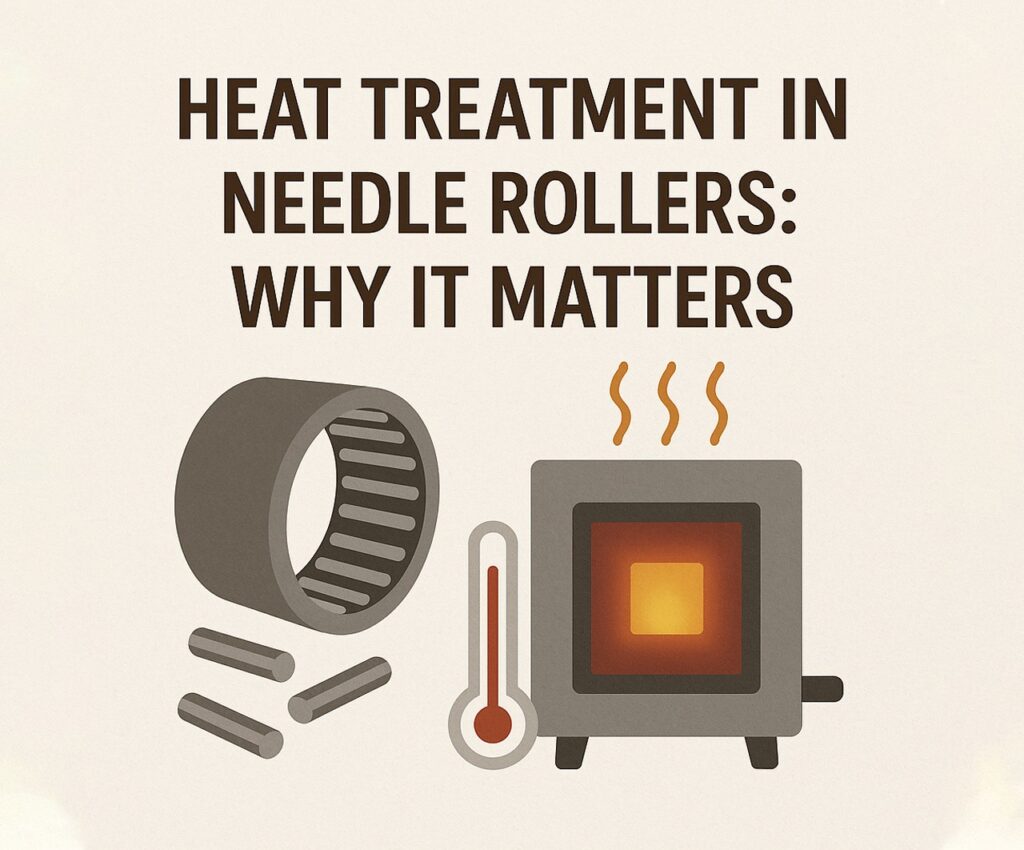In the world of precision motion and high-performance machinery, the smallest components often bear the heaviest loads—literally. This is especially true for needle rollers, the unsung heroes of many bearing assemblies. Whether you’re selecting a cage needle roller bearing, using a needle roller bearing puller during maintenance, or fine-tuning your design around a specific needle roller bearing size, one thing becomes critically important: heat treatment. It’s not just a finishing step; it’s a defining process that determines strength, durability, and overall bearing performance.
In this article, we dive into why heat treatment is so crucial for needle rollers, what it involves, and how it impacts the reliability of bearings in automotive, industrial, and high-speed applications. Know More
The Role of Needle Rollers in Bearing Systems
Before we get into metallurgy, it’s important to understand what needle rollers do. Unlike traditional ball bearings, needle bearings use cylindrical rollers that are thin and long in proportion to their diameter. This unique design allows for high radial load capacity in a compact space.
A cage needle roller bearing uses a cage to maintain the spacing of the rollers, ensuring even load distribution and reduced friction. Proper handling with tools like a needle roller bearing puller is crucial during assembly and disassembly to prevent damage, especially when dealing with varying needle roller bearing size configurations.
What Is Heat Treatment?
Heat treatment refers to a group of industrial and metalworking processes used to alter the physical and sometimes chemical properties of a material. For needle rollers, this generally involves:
- Hardening: Heating to a high temperature followed by rapid cooling (quenching)
- Tempering: Reheating to a lower temperature to reduce brittleness
- Case Hardening: Creating a hard outer layer while maintaining a tough inner core
These steps are essential for ensuring that each cage needle roller bearing performs under stress without wearing out or fracturing prematurely.
Why Heat Treatment Matters for Needle Rollers
1. Load Bearing Capacity
Needle rollers carry concentrated loads over small contact areas. Without proper hardening, the rollers could deform or flatten, compromising the entire bearing.
2. Fatigue Resistance
Repeated stress cycles can cause material fatigue. Heat-treated rollers are more resistant to micro-cracks and spalling, which is especially important for bearings running at high RPMs.
3. Wear Resistance
In applications with continuous motion, such as in automotive transmissions or conveyors, wear resistance is vital. Treated surfaces withstand abrasion far better than untreated steel.
4. Dimensional Stability
Different needle roller bearing size units must maintain tight tolerances. Heat-treated materials resist thermal expansion and deformation during operation.
The Heat Treatment Process for Needle Rollers
1. Material Selection
Most needle rollers are made from high-carbon chromium steel or alloy steels such as AISI 52100. The choice of material influences how well the part responds to heat treatment.
2. Hardening & Quenching
Needle rollers are heated to around 800–850°C and then rapidly cooled in oil or salt baths. This locks in a martensitic structure that gives them high hardness.
3. Tempering
After hardening, rollers are tempered at around 150–200°C to reduce internal stresses and brittleness. This ensures a good balance between hardness and toughness.
4. Case Hardening (Optional)
Some cage needle roller bearing systems use case-hardened rollers with a softer core. This improves shock resistance while maintaining a hard outer shell.
Common Issues Without Proper Heat Treatment
If the heat treatment process is skipped or done incorrectly, the results can be catastrophic:
- Premature Failure: Soft rollers will deform under load.
- Spalling and Pitting: Without adequate surface hardness, rolling contact fatigue causes pitting.
- Dimensional Inconsistencies: Rollers may warp, affecting clearance and load distribution.
These failures are difficult to correct once the bearing is installed, especially in systems where a needle roller bearing puller must be used for precise disassembly.
Industry Applications That Depend on Heat-Treated Needle Rollers
Automotive Transmissions
- Use high-RPM cage needle roller bearing units
- Require extremely tight needle roller bearing size tolerances
- Rely on case-hardened rollers for durability
Hydraulic Pumps and Compressors
- Operate under high pressure and speed
- Require dimensional stability
- Benefit from low-friction, wear-resistant surfaces
Aerospace Actuation Systems
- Weight and reliability are critical
- Custom heat treatment profiles enhance performance without adding mass
The Connection to Needle Roller Bearing Size
Different applications demand specific needle roller bearing size configurations. Heat treatment must be tailored to each size, as:
- Smaller rollers may over-harden and become brittle
- Larger rollers need uniform heating and cooling to avoid soft spots
Bearings also need to be compatible with extraction tools like a needle roller bearing puller, especially during maintenance cycles. Inconsistent hardness can make these procedures difficult or damage components.
Advanced Technologies in Heat Treatment
Modern heat treatment has evolved. Some cage needle roller bearing manufacturers now use:
- Induction Heating: For localized treatment
- Vacuum Heat Treatment: Reduces oxidation for cleaner parts
- Cryogenic Treatment: Enhances dimensional stability further
These technologies are pushing needle roller performance beyond traditional limits, making them suitable for demanding environments like electric vehicles or automated manufacturing lines.
Quality Assurance and Standards
Top-tier manufacturers conduct rigorous testing to ensure every heat-treated roller meets global standards like:
- ISO 683-17 (heat-treatable steels)
- ASTM A534 (bearing steel specifications)
They also test for:
- Hardness (Rockwell or Vickers)
- Microstructure analysis
- Dimensional checks
This commitment to quality ensures that each cage needle roller bearing delivers consistent performance over its entire service life.
Final Thoughts
Heat treatment isn’t a luxury—it’s a necessity for ensuring that cage needle roller bearing systems perform under pressure, last longer, and operate more smoothly. Whether you’re pulling a bearing with a needle roller bearing puller, selecting based on needle roller bearing size, or designing new mechanical systems, knowing the role of heat treatment gives you a crucial edge.
In short, behind every high-performance needle roller is a carefully controlled thermal process that makes or breaks the entire system.

